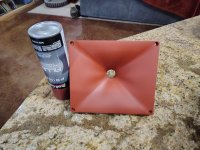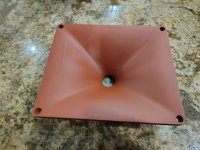Actually, I realized that the adapter used in that picture was yet a bit different - the difference probably won't be big but here's the same adapter used for that measurement: https://at-horns.eu/ext/T520-STD-V3.zipTry this - https://cults3d.com/:2779198
So at least this one should suit the DH450 very well.
I know because I painted it 🙂 It's an acrylic paint, I don't remember the brand of this one specifically, but they all work about the same. Paints are usually sold in tubes like this:Hello, does anyone know what type of paint is used on the horn?
I used fluorescent orange, if you apply it 1-2 layers on a white base, it gives an acid fluorescent color. But if you apply it in 3-4 layers on a dark base, you get something like in the photo, there is a slight effect of light reflection, but it gives only a slight accent.
I applied the paint using a medium pore sponge. This gives such a rough finish, and makes the color more matte and deep. The paint can also be applied smoothly, but the rough finish forgives minor imperfections and reduces sanding time.
Well, obviously any 2" throat horn. It can be an ATH Gen2 horn with the 2" adapter (T520-50-STD-1), or any other you can source. It will be more on the beamy side at high frequencies but there are people who love it, still.What choice do I have? I have the drivers.
A (very) quick raw measurement of Celestion CDX1-1720 + A520G2 (with the above adapter):

7.5 ms window (including some reflections):

This seems to be another great combination.
7.5 ms window (including some reflections):
This seems to be another great combination.
CDX1-1720 / A520G2
25-STD-3 (blue) vs 25-EXT-2 (black) adapter, 10 cm in front of the mouth, ~8.5 ms window, no smoothing:

25-STD-3 (blue) vs 25-EXT-2 (black) adapter, 10 cm in front of the mouth, ~8.5 ms window, no smoothing:
CDX1-1720 (blue) vs DFM-2535 (red) under the same conditions.
(A460G2 + 25-EXT-2)

(A460G2 + 25-EXT-2)
What do you guys think about this impulse response on my sub: That is 100% at the X with the first negative impulse being -80%. Do you think this is correct phase?

Subwoofers are inherently slow devices, so I don't think you would need to examine the impulse response(s) per se. It's what the room does to the sound waves what actually dominates the situation in the end. Measure simply the steady state frequency responses around the listening position instead.
Hey this is weird and i would be interested in your insight guys: Red line is measured L+R in room after tuning - Blue and Green is L and R separate and Orange is L+ Inverted R. This tells me the horns are out of phase from each other? Very strange
Haha the out of phase version that measures better, sounds so very strange, like the centre image is behind you.
The step response can tell you if the drivers on your speakers are in the same phase (well, and inspecting the wires))) The dips on a two-speaker measurement are very dependent on the position of the microphone, so they are difficult to estimate.This tells me the horns are out of phase from each other?
Maybe you should start a separate thread on creating a crossover for your system, where you could post all the graphs and get help from crossover-experienced forum members? It's just that the measurements look wrong all the time, and it's pretty hard to guess why, and there may not be enough room in this thread to sort it out step by step.
Yup fair enough thanks
The horns look cool anyway - and to be honest sound really good too. Measuring them might have been a mistake 😀
The horns look cool anyway - and to be honest sound really good too. Measuring them might have been a mistake 😀
I know that once successfully tuned, these horns will bring real pleasure!The horns look cool anyway - and to be honest sound really good too. Measuring them might have been a mistake 😀
(As another idea, don't your woofers play above kilohertz? That could create dips as well. But there are too many options for guessing, you need to make a set of quality measurements of all drivers and understand what goes wrong, surely the reasons will be found and they will not be difficult to fix)
- Home
- Loudspeakers
- Multi-Way
- Acoustic Horn Design – The Easy Way (Ath4)

